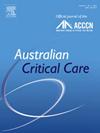The influence of sex on early postoperative opioid administration after cardiac surgery
IF 2.7
3区 医学
Q2 CRITICAL CARE MEDICINE
引用次数: 0
Abstract
Background
Female patients are at an increased risk of experiencing severe postoperative pain and developing chronic pain after cardiac surgery. However, the impact of sex on postoperative opioid administration is underexplored.
Methods
This single-centre retrospective cohort study included adults undergoing coronary artery bypass grafting, valve surgery, or a combined procedure at a quaternary referral hospital, between November 2012 and June 2021. Patients were classified as female or male based on biological sex. Opioid doses were converted to oral morphine equivalent daily doses (oMEDDs) to enable comparisons. Energy balancing was used to adjust for baseline differences, including body weight and other confounders. Sex differences in gabapentinoid and antipsychotic drug administration were also evaluated. The aim of this study was to evaluate the association of patient sex and perioperative opioid administration after cardiac surgery.
Results
We studied 3188 patients: 825 (25.9%) females and 2363 (74.1%) males. After adjusting for body weight and other confounders, female patients received significantly less opioid analgesia on postoperative day 1 (oMEDD difference: −5.70 mg [95% confidence interval {CI}: −3.15 to −8.25], p < 0.0001), day 2 (oMEDD difference: −9.06 mg [95% CI: −5.05 to −13.08], p < 0.0001), and day 3 (oMEDD difference: −4.50 mg [95% CI: −0.52 to −8.47], p < 0.03). Female patients were also more likely to be prescribed a gabapentinoid (odds ratio: 1.47 [95% CI: 1.02 to 2.13], p = 0.04) but less likely to be prescribed an antipsychotic (odds ratio: 0.63 [95% CI: 0.46–0.86], p = 0.004).
Conclusion
In a single-centre cohort study involving over 3000 cardiac surgery patients, female sex was associated with the administration of significantly lower doses of postoperative opioid. Providers involved in the care of cardiac surgery patients should be aware of the potential for implicit bias, and further studies are required to identify mechanisms for the observed disparities.
性别对心脏手术后早期阿片类药物给药的影响
女性患者在心脏手术后经历严重的术后疼痛和发展为慢性疼痛的风险增加。然而,性别对术后阿片类药物给药的影响尚未得到充分探讨。方法本单中心回顾性队列研究纳入了2012年11月至2021年6月期间在一家第四转诊医院接受冠状动脉搭桥术、瓣膜手术或联合手术的成年人。根据生理性别将患者分为女性和男性。阿片类药物剂量转换为口服吗啡当量日剂量(oMEDDs),以便进行比较。能量平衡用于调整基线差异,包括体重和其他混杂因素。性别差异在加巴喷丁类和抗精神病药物的使用也进行了评估。本研究的目的是评估心脏手术后患者性别与围手术期阿片类药物使用的关系。结果3188例患者中,女性825例(25.9%),男性2363例(74.1%)。在调整体重和其他混杂因素后,女性患者术后第1天阿片类药物镇痛量明显减少(oMEDD差异:−5.70 mg[95%可信区间{CI}:−3.15至−8.25],p <;0.0001),第2天(oMEDD差异:−9.06 mg [95% CI:−5.05 ~−13.08],p <;0.0001),第3天(oMEDD差异:- 4.50 mg [95% CI: - 0.52至- 8.47],p <;0.03)。女性患者也更可能被开加巴喷丁类药物(优势比:1.47 [95% CI: 1.02至2.13],p = 0.04),但更不可能被开抗精神病药物(优势比:0.63 [95% CI: 0.46至0.86],p = 0.004)。结论在一项涉及3000多例心脏手术患者的单中心队列研究中,女性与术后阿片类药物的使用剂量显著降低有关。参与心脏手术患者护理的提供者应该意识到潜在的内隐偏倚,需要进一步的研究来确定观察到的差异的机制。
本文章由计算机程序翻译,如有差异,请以英文原文为准。
求助全文
约1分钟内获得全文
求助全文
来源期刊

Australian Critical Care
NURSING-NURSING
CiteScore
4.90
自引率
9.10%
发文量
148
审稿时长
>12 weeks
期刊介绍:
Australian Critical Care is the official journal of the Australian College of Critical Care Nurses (ACCCN). It is a bi-monthly peer-reviewed journal, providing clinically relevant research, reviews and articles of interest to the critical care community. Australian Critical Care publishes peer-reviewed scholarly papers that report research findings, research-based reviews, discussion papers and commentaries which are of interest to an international readership of critical care practitioners, educators, administrators and researchers. Interprofessional articles are welcomed.
 求助内容:
求助内容: 应助结果提醒方式:
应助结果提醒方式:


